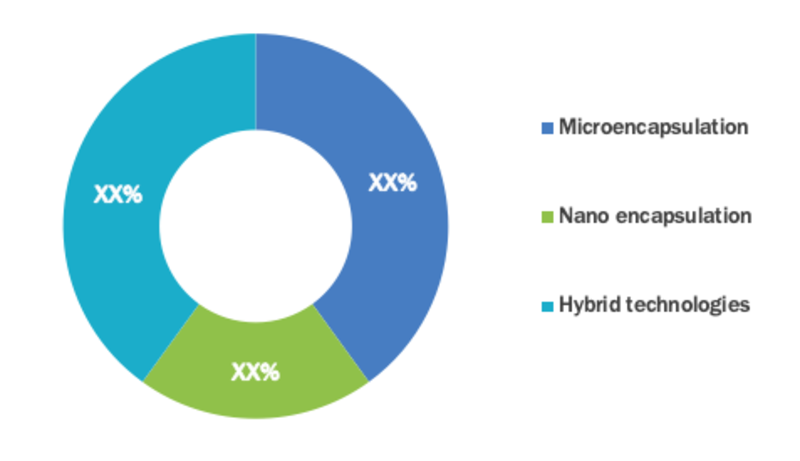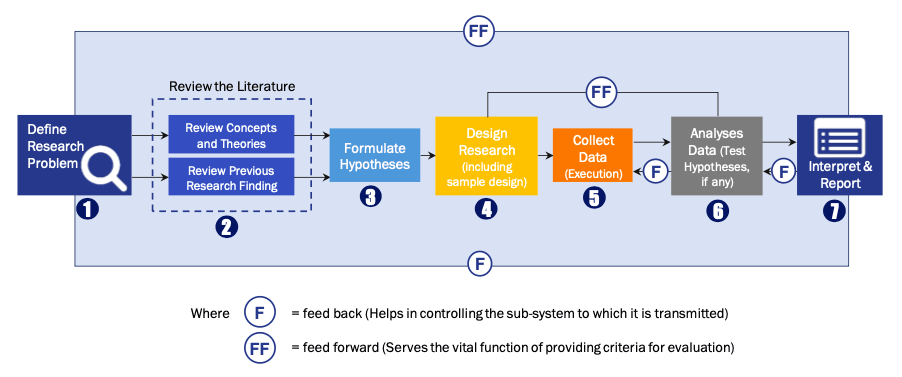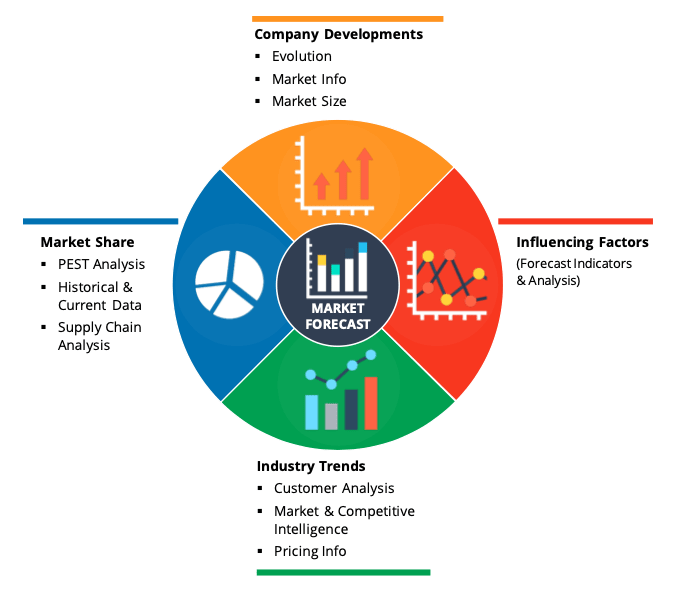Food Encapsulation Market Overview
The food & liquid industry will maintain the colour, taste, and nutritional worth of food products along with increasing their shelf-life using encapsulation techniques. The bio active molecules provide an undesirable taste or color to health foods, that has boosted the application of food encapsulation in color and style masking. furthermore, the increasing demand for tasteful food merchandise drives the marketplace for flavor stabilization. Flavor stabilization is additionally a growing market, with the enlarged demand for flavored food merchandise. Encapsulation or microencapsulation of flavors consists of protecting a flavoring agent or a mix of molecules with a dedicated envelope. Encapsulation will limit the degradation or loss of flavor throughout the varied production processes and storage. The envelope may also give functional properties, like a controlled release of aromatic molecules during a given atmosphere like water (if tasteful tea), mouth (solid food: candy, toothpaste), or spray.
The major drawback two-faced by food makers is maintaining the physical stability of encapsulated food at the time of process and unharness. intensive analysis is allotted for reducing the capsule size for more improvement of the bioavailability of materials. The enlarged bioavailability can lead to the intensive use of the encapsulation method for a large vary of food merchandise. Hence, it's necessary to specialise in reducing the dimensions of the capsule for increasing its utility. effectiveness of active ingredients.
The development and commerce aspects of practical food ingredients are complex, expensive, and unsure. Factors behind the success of product development embody technological conditions, consumer demand, and legislative regulatory background. Substantial investment is needed for the R&D of a strain to be used for regulatory of latest practical ingredients like probiotics.
| Report Metric | Details |
| Market size available for years | 2023–2030 |
| Base year considered | 2023 |
| Forecast period | 2024–2030 |
| Forecast unit | Value (USD Million) |
| Segments covered | Technology, Material type, Core phase and Region |
| Regions covered | North America (the U.S. and Canada), Europe (UK, Germany, France, Italy, Spain, Russia, Rest of Europe), Asia-Pacific (China, India, Japan, Australia, South East Asia, Rest of Asia Pacific), Latin America and the Middle East and Africa (Brazil, Saudi Arabia, UAE, Rest of LAMEA) |
| Companies covered | Cargill, Incorporated, BASF, DuPont,DSM, FrieslandCampina, Kerry, Ingredion International Flavors & Fragrances Inc. IFF, Symrise, Sensient Technologies Corporation, Blachem Inc., Firmenich SA, Vitablend, Advanced Bionutrition Corp, Encpasys LLC, Clextral, Sphera Encapsulation, Aveka, Lycored, Tastetech . |
The covid-19 Impact on Food Encapsulation Market:
Like several different industries, COVID-19 badly knocked the electronic and semiconductor trade. This new event has compact nearly 230 countries in exactly a couple of weeks, leading to the forced conclusion of producing and transportation activities at intervals and across the countries. This has directly affected the expansion of the sector. It's calculable that COVID-19 to depart over USD thirty billion impacts on the physics and semiconductor trade. The arena is majorly affected thanks to transport restrictions on major physics and semiconductor staple suppliers. However, the rising want for semiconductors in many industries can supply fast market recovery over the longer-term amount.
Food Encapsulation Market Segment Overview

By Technology, Microencapsulation account for the largest market size of food encapsulation market . Microencapsulation is employed to supply AN improved quality of ingredients in food product. This technology is employed for shielding the core ingredients from interacting with alternative ingredients whereas process the food product and for shielding them from the external atmosphere.
By Material type, Microencapsulation of probiotics is taken into account AN optimum strategy against adverse conditions in food .Microencapsulation additionally permits the mixture of probiotics with materials promoting their growth and attachment within the viscus (prebiotics). It is, therefore, attainable to develop optimum cocktails of probiotics and prebiotics in an exceedingly single formulation referred to as “symbiotic.” several vitamins, plant extracts, unsaturated fatty acids area unit of hydrophobic liquids; combining such compounds in an exceedingly hydrophilic food powder is finished by encapsulation. additionally to protection, microencapsulation permits the conversion of ingredients to free-flowing, simply suspendable (such as hydrophobic vitamins in fruit juices), and dispersible (such as cocoa in cold milk) powders
By Core Phase, The probiotics section is projected to record the best CAGR throughout the forecast amount.Probiotics supply health advantages, like hindrance from looseness of the bowels among kids, increased nutrient bioavailability and hereditary disease, improved immunity levels by control lymphocytes and antibodies, and hindrance of sure cancers by reducing the conversion levels of digestive fluid into a matter, a cancer-causing substance. thanks to the assorted health advantages, prebiotics is extensively utilized in the food business within the purposeful food section.
Market Analysis, Insights and Forecast – By Technology
· Microencapsulation
· Nano encapsulation
· Hybrid technologies
Market Analysis, Insights and Forecast – By Material Type
· Polysaccharides
· Proteins
· Lipids
· Emulsifiers
· Other Shell Materials
Market Analysis, Insights and Forecast – By Core Phase
· Vitamins
· Minerals
· Enzymes
· Organic Acids
· Additives
· Probiotics
· Prebiotics
· Essential oils
· Other Core Phase Materials
Food Encapsulation Market Regional Overview
Region-wise, in terms of regions,North America holds the largest share within the food encapsulation market globally. The high availability of shell materials like hydrocolloid, emulsions and also the presence of an oversized range of makers area unit causative to the expansion of the region. The Asia Pacific is has witnessed important growth within the last number of years, owing to the increasing demand for processed food and also the flourishing food and potable industry. the expansion of the region is additionally fuelled by speedy urbanization, rising income, up living standards, notably in rising countries as well as China and india. the expansion of Europe is attributed to the increasing advancements in technologies employed in the processed food sector.
Food Encapsulation Market, By Geography
· North America (US & Canada)
· Europe (UK, Germany, France, Italy, Spain, & Rest of Europe)
· Asia-Pacific (Japan, China, India, Australia, & South Korea, & Rest of Asia-Pacific)
· LAMEA (Brazil, Saudi Arabia, UAE & Rest of LAMEA)
Food Encapsulation Market Competitor overview
Some key developments and strategies adopted by manufacturers in the Food Encapsulation are highlighted below.
· In 2021, BASF SE has agreed with Sandoz GmbH, a subsidiary of Novartis, to invest at the Kundl/Schaftenau campus in austria. This agreement allows BASF SE to any develop its production footprint for enzymes and biotechnology product
Food Encapsulation Market, Key Players
· Cargill, Incorporated
· BASF
· DuPont
· DSM
· FrieslandCampina
· Kerry
· Ingredion
· International Flavors & Fragrances Inc. IFF
· Symrise
· Sensient Technologies Corporation
· Blachem Inc.
· Firmenich SA
· Vitablend
· Advanced Bionutrition Corp
· Encpasys LLC
· Clextral
· Sphera Encapsulation
· Aveka
· Lycored
· Tastetech
Q1. What is the total CAGR expected to be recorded for the Food Encapsulation market during the forecast period?
Food Encapsulation market is expected to record a CAGR of ~ 6.8% during the forecast period.
Q2. Which segment is projected to hold the largest share in the Food Encapsulation Market?
Probiotics segment is projected to hold the largest share in the Food Encapsulation Market.
Q3. What are the driving factors for the Food Encapsulation market?
Encapsulation or microencapsulation of flavors consists of protecting a flavoring agent or a mix of molecules with a dedicated envelope. Encapsulation will limit the degradation or loss of flavor throughout the varied production processes and storage. This is key factors that boost the growth of the Food Encapsulation market progressively.
Q4. Which Segments are covered in the Food Encapsulation market report?
Technology , Source, and Core Phase and Region, these segments are covered in the Food Encapsulation market report
Q5. Which are the prominent players offering Food Encapsulation ?
Cargill, Incorporated , BASF , DuPont ,DSM , FrieslandCampina , Kerry , Ingredion International Flavors & Fragrances Inc. IFF ,Symrise, Sensient Technologies Corporation , Blachem Inc. , Firmenich SA , Vitablend , Advanced Bionutrition Corp , Encpasys LLC , Clextral ,Sphera Encapsulation , Aveka , Lycored , Tastetech .
Data Library Research are conducted by industry experts who offer insight on industry structure, market segmentations technology assessment and competitive landscape (CL), and penetration, as well as on emerging trends. Their analysis is based on primary interviews (~ 80%) and secondary research (~ 20%) as well as years of professional expertise in their respective industries. Adding to this, by analysing historical trends and current market positions, our analysts predict where the market will be headed for the next five years. Furthermore, the varying trends of segment & categories geographically presented are also studied and the estimated based on the primary & secondary research.
In this particular report from the supply side Data Library Research has conducted primary surveys (interviews) with the key level executives (VP, CEO’s, Marketing Director, Business Development Manager and SOFT) of the companies that active & prominent as well as the midsized organization
FIGURE 1: DLR RESEARH PROCESS

Extensive primary research was conducted to gain a deeper insight of the market and industry performance. The analysis is based on both primary and secondary research as well as years of professional expertise in the respective industries.
In addition to analysing current and historical trends, our analysts predict where the market is headed over the next five years.
It varies by segment for these categories geographically presented in the list of market tables. Speaking about this particular report we have conducted primary surveys (interviews) with the key level executives (VP, CEO’s, Marketing Director, Business Development Manager and many more) of the major players active in the market.
Secondary ResearchSecondary research was mainly used to collect and identify information useful for the extensive, technical, market-oriented, and Friend’s study of the Global Extra Neutral Alcohol. It was also used to obtain key information about major players, market classification and segmentation according to the industry trends, geographical markets, and developments related to the market and technology perspectives. For this study, analysts have gathered information from various credible sources, such as annual reports, sec filings, journals, white papers, SOFT presentations, and company web sites.
Market Size EstimationBoth, top-down and bottom-up approaches were used to estimate and validate the size of the Global market and to estimate the size of various other dependent submarkets in the overall Extra Neutral Alcohol. The key players in the market were identified through secondary research and their market contributions in the respective geographies were determined through primary and secondary research.
Forecast Model
